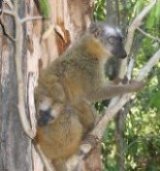Brown Lemurs (Eulemur fulvus rufus x collaris) |
-Ruoso.jpg)
© Cyril Ruoso, www.ruoso-grundmann.com
More info about brown lemurs... |
Brown lemurs were first introduced to Berenty inadvertently during a cyclone in 1975. These were a group of about 8 pet red-fronted lemurs (E. fulvus rufus) originally brought from the west of Madagascar near Morondava. Later the de Heaulme family added 8 or 10 pets and orphaned brown lemurs from Fort Dauphin markets. They, however, were the red-collared subspecies from the rainforest near Fort Dauphin (E.f. collaris). The two subspecies are opposite ends of a horseshoe distribution of brown lemur varieties which stretch round the North of Madagascar. Some authorities consider them separate species. They have different numbers of chromosomes. They should not be able to hybridize, but they pay no attention to the authorities. As of 2005, there are over 250 browns in the 1 km2 Malaza section of the reserve, according to research by Susan Pinkus, John Walker and Josia Razafindramanana.
Brown lemurs do not have total female dominance: it depends on the individual. They do not defend territory as sharply as the ringtails, but instead range to wherever is the current best food source. Their male-female troops in the rich habitat of Berenty can number up to twenty, larger than norms elsewhere. They have one infant a year, carried transversely like a money-belt, not longitudinally like the ringtails. The infants initially develop slowly, remaining on the mother for about two months, but then accelerate. Browns are adult size at a little over a year and may breed at two years.
They are dominant over the ringtails and can claim favored trees, especially in the shady tamarind forest. They may be pushing the ringtails increasingly into more peripheral habitats, which is classic behavior in west-coast forests where ringtails, browns, and white sifaka co-exist naturally.
Read more about lemurs by navigating to:
_MASTimg_BreakfastMale_(DC).jpg)
_MASTimg_BerentyWebsiteMasthead.jpg)




